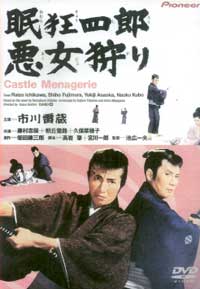 Masterless samurai Kyoshiro Nemuri always dresses in a long dark colored kimono, unpatterned except for his family crest. Unlike most ronin characters, he never wears the hakama trousers generally worn by all men of his class. The costume is so recognizable that a viewer familiar with the feature film series need not see the character's face, or await an introduction, to know instantly who we see.
Masterless samurai Kyoshiro Nemuri always dresses in a long dark colored kimono, unpatterned except for his family crest. Unlike most ronin characters, he never wears the hakama trousers generally worn by all men of his class. The costume is so recognizable that a viewer familiar with the feature film series need not see the character's face, or await an introduction, to know instantly who we see.
Castle Menagerie (Nemuri Kyoshiro: Akujo gari, 1969) introduces us in the opening sequence to the familiar swordsman exclusively by his costume alone, without our seeing his face. He is busying himself killing innocent men & raping innocent women.
We suspect an imposter right away, but the thing is, for anyone who has seen a number of films in this series, it is not quite inconceivable that the infamous anti-hero could act in this way, though it would be discomforting had it really been him.
When the real Kyoshiro is later attacked by an avenging daughter, he denies having killed her father, & with his usual haughtiness instructs her to seek a woman's happiness instead of vengeance.
So maybe Kyoshiro isn't the fellow who is raping & killing at random, but he's not exactly a nice guy either. In fact, he's not even bothered that someone is imitating him. "There's no law saying there can't be two Kyoshiros!"
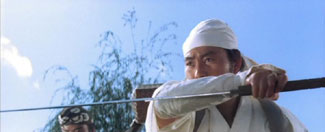 When he catches the imposter in a villainous act, he only watches, then walks away, not caring if his name is smeared. When he catches the imposter in a villainous act, he only watches, then walks away, not caring if his name is smeared.
He is already considered a bad man by many people, & he might as well be regarded all the more so due to someone else's efforts.
In a series of colorful & attractive set-pieces, we learn that the head of the Shogun's wives, Lady Nishikikoji (Naoko Kubo) in Edo castle, is an evil, ambitious woman who uses people for her own purposes, & kills them after.
The Kyoshiro impersonator is a Christian under Lady Nishikikoji's influence, assassinating whoever stands in the way of the Lady's way. Blame is placed on Kyoshiro for reasons never entirely logical, except that it brings our series hero into the picture.
The imposter foolishly believes he will be rewarded with passage for himself & fifty-eight other secret Christians, who want to go to Luzon in the Philippines to escape persecution. It's obvious to everyone but himself that he'll just be killed by Lady Nishikikoji when she has no further use for him.
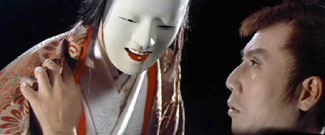 The story is extraordinarily misogynist, justified in part by the nature of Kyoshiro who is blase & sadistic. The story is extraordinarily misogynist, justified in part by the nature of Kyoshiro who is blase & sadistic.
In this episode as in others, the female villain will be reduced to extreme desire for Kyoshiro before he kills her, in this instance by using her as a shield against an arrow.
Considering the film's ugly portrait of women's interactions within Edo castle, it is interesting to note one unusually positive female character. Shiho Fujimura plays Osano, the sister of the man impersonating Kyoshiro & like him a secret Christian. She possesses a nobility lacking in any other character in the film.
In a brief lesbian scene, tacky but not distasteful, we are not merely being offered a bit of soft porn, but are learning something about this character. Unlike the majority of women in the majority of episodes, including other characters portrayed by Shiho, Osano does not at all fall in love with Kyoshiro, & this would seem to be due to her attraction to women.
At the same time she is excruciatingly moral, & suffers over her brother's actions, as well as trying to keep Lady Nishikikoji from torturing & killing people.
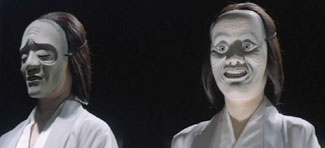 The cinematography & set design for several scenes are stylized like block print designs. The cinematography & set design for several scenes are stylized like block print designs.
In one impactful scene, Iga ninja spies, including a female spy or kunoichi, have desguised themselves as flying tengu (long-nosed devils) & try to convince Kyoshiro to make love to a masked virgin.
But he sees through the trick & knows the lips of the mask are poison, & cannot be fooled that a woman is virgin when she is not.
Such eroticism of masks appears in a number of Japanese films, including the Kyoshiro episode The Mask of the Princess (Nemuri Kyoshiro: Tajo-ken, 1965). This is perhaps incomprehensible to most modern westerners, but collectors of erotica from Elizabethan to Victorian times will see a parallel recurrence of "anonymity" liaisans with bird masks with long beaks or ball masks.
The mask sequence is also fascinating because it is staged as pure art, almost like a modern jazz dance, with no attempt to approach realism.
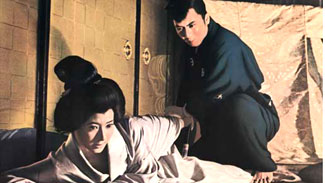 The action sequences are intense or overdone, but should satisfy any audience. The action sequences are intense or overdone, but should satisfy any audience.
There's an effort on the part of the scriptwriter & director to tie action scenes into bits of plot & character, a good thing even when events are contrived.
For instance, we are introduced to a poor samurai & a teahouse girl failing in their attempt at love-suicide. They are tied in the town square & humiliated. Kyoshiro passes by & true to his character doesn't make the least effort to help them. He is suddenly attacked bya group of Iga ninja disguised as tradesmen.
A brief battle against a variety of weapons concludes with the suicidal couple accidentally slain. Or could be that Kyoshiro placed himself in such a manner that a failed effort to kill him would kill the lovers instead, as they desired? Kyoshiro's villainy is always ambiguous.
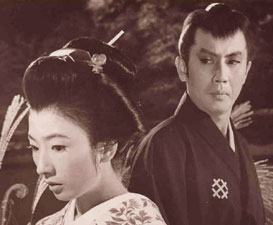 The climactic battle is against his own shadow, Shuman, who has learned Kyoshiro's engetsu Full Moon sword style. The climactic battle is against his own shadow, Shuman, who has learned Kyoshiro's engetsu Full Moon sword style.
There is a little good choreography in their encounter, but mainly it is an artsy & nearly stationary tableau in which we see both duelists making identical preliminary movements before clashing.
A degree of tension is created by this slow encounter, for it is every Kyoshiro fan's first time seeing how Kyoshiro fights off his own invincible style.
The only reason Kyoshiro agreed to the duel, he admits, is because Shuma was a hypocrit. Though Kyoshiro didn't mind being impersonated, & was not bothered by Shuma's evil deeds, what grated on him was that such a fiendish man would dare to have religious convictions.
As in other episodes we are observing Kyoshiro's love/hate feelings regarding Christianity, himself the red-haired bastard son of a Portugese Jesuit priest turned Satanist.
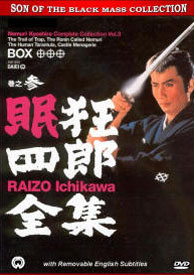 A couple small asides for this episode, first a small thing that captured my attention: The evil superintendent of Edo castle is cross-eyeed in his introductory scenes, not in any comical way, but after the fashion of actor woodblock prints of the ukiyo "floating world" era of art. A couple small asides for this episode, first a small thing that captured my attention: The evil superintendent of Edo castle is cross-eyeed in his introductory scenes, not in any comical way, but after the fashion of actor woodblock prints of the ukiyo "floating world" era of art.
A heroic character in Shinobi no shu (Mission Iron Castle, 1970) was likewise a cross-eyed character, this appearance signifying intensity of feeling & adopted from the kabuki stage.
To regular chambara filmlovers, the cross-eyed character, whether hero or villain, isn't the least whimsical, but to a viewer who has never seen such expressions in a seriously-meant film, it can be distracting the first time. It's not so commonly used in cinema as to ever become unnoticeable when it occurs, but it only takes a couple exposures to realize the purpose.
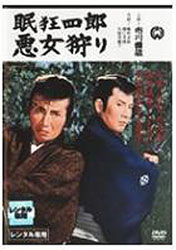 This was the twelfth & final "Full Moon Swordsman" or "Sleepy Eyes of Death" episode starring Raizo Ichikawa, who died rather young at the height of his career. This was the twelfth & final "Full Moon Swordsman" or "Sleepy Eyes of Death" episode starring Raizo Ichikawa, who died rather young at the height of his career.
A couple more episodes would be made starring Hiroki Matsukata, but a grieving public was not yet ready to accept anyone else playing a role which Raizo had made so much his own. Raizo knew he was dying of cancer during the shoot, & when viewers know this, it lends an unexpected layer of meaning to every scene.
His director for this final outing was Kazuo Ikehiro, who likewise knew it was liable to be the star's final film. So if a viewer cannot help but overlay a bit of sadness to the tale that is not really in the script, such sentiment would certainly have been present in the director as well as the star.
As a farewell film for a greatly beloved star, it is not a movie of tremendous consequence. But Ikehiro was often a fascinating director who used action to convey deeper meanings, & was excellent at lending lending severity & credibility even to films with plots that approach silliness. As one of the more exaggerated tales of Kyoshiro, it is winning & unusual, not just more-of-same in the long-running series.
copyright © by Paghat the Ratgirl
|
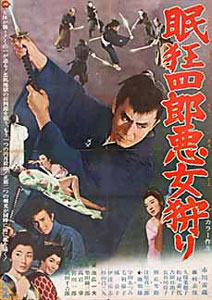

 When he catches the imposter in a villainous act, he only watches, then walks away, not caring if his name is smeared.
When he catches the imposter in a villainous act, he only watches, then walks away, not caring if his name is smeared. The story is extraordinarily misogynist, justified in part by the nature of Kyoshiro who is blase & sadistic.
The story is extraordinarily misogynist, justified in part by the nature of Kyoshiro who is blase & sadistic. The cinematography & set design for several scenes are stylized like block print designs.
The cinematography & set design for several scenes are stylized like block print designs. The action sequences are intense or overdone, but should satisfy any audience.
The action sequences are intense or overdone, but should satisfy any audience. The climactic battle is against his own shadow, Shuman, who has learned Kyoshiro's engetsu Full Moon sword style.
The climactic battle is against his own shadow, Shuman, who has learned Kyoshiro's engetsu Full Moon sword style.
 This was the twelfth & final "Full Moon Swordsman" or "Sleepy Eyes of Death" episode starring Raizo Ichikawa, who died rather young at the height of his career.
This was the twelfth & final "Full Moon Swordsman" or "Sleepy Eyes of Death" episode starring Raizo Ichikawa, who died rather young at the height of his career.